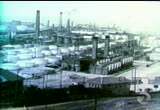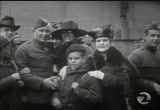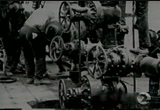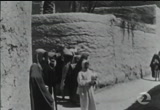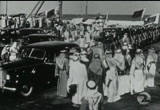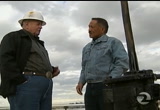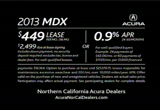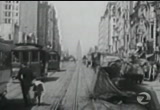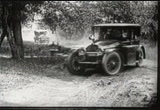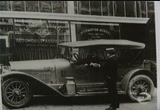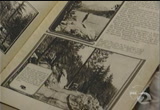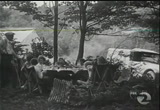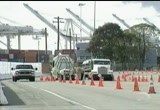tv Second Look FOX December 16, 2012 11:00pm-11:30pm PST
11:01 pm
up next on a second look, black gold in the golden state. where oil comes from in california. and the state's role in opening up the oil fields of saudi arabia. >> plus when you have a flat tire who do you call? we'll have the history of the aaa. hello everyone and welcome to a second look. i'm frank somerville. tonight oil in california. one of the keys to the state's oil processing happens to be right here in the bay area. it's the chevron refinery in richmond. chevron's predecessor standard oil began construction on the refinery back in 1801 four years before richmond
11:02 pm
incorporated as a city. it first began processing oil in 1902. today the refinery has the capacity to take in 350,000- barrels a day and turn it into gasoline, jet fuel, diesel, lubricating oil and others the refinery has been shut down since a fire at the refinery but chevron expects it to be back into capacity three months into the new year. in 1991 ktvu's george watson looked at how demand grew in the early part of the 20th century. >> in 1917 when america entered world war i it was supplying half of the oil required to fight the war.
11:03 pm
the use of oil revolutionized the way war is waged. oil fueled the planes, tanks, trucks and ships that fight wars. the end of the war actually increased the world's need for oil. by of the war, america was consuming oil faster than america could produce. the competition was stiff especially from the british and dutch oil interest. in 1919 american companies were spending $400 million in marketing and oil refining by 1925 they were spending a billion dollars on exploration alone. at home oil began to literally gush. production doubled from 1918 to 1923. by 1929 it had tripled and passed the billion barrel mark for the first time. but the greatest oil discovery
11:04 pm
was yet to be made. standard oil company of california discovered oil on the tiny island of bahrain. success there convinced saudi arabian king. the agreement was for 66 years. but the saudi desert was proving to be as barren as it looked. after six years of searching they found oil in saudi arabia and the rest is history. >> the subsidiary that they formed for oil in saudi arabia changed their name for aramco. they gathered for a reunion and
11:05 pm
among them was sam ranco who shot film back in the 1930s. standard oil showed some of his footage. >> all you could do is dawn the red sea by boat to disembark in jeta. this was inside of jeta it was a wild town. there's probably a four lane road right where that site is. >> exactly, exactly. >> there's the water carrier. five gallon cans. here's the sprinkling man. working for the municipality. the trip was a survey to find out to look at the logistics of moving saudi arabian crude, the discovery had been made. there were limited markets east that had been supplied mainly from indonesia then the east indies and this was a case of
11:06 pm
standard of california -- >> excuse me that's the gate. >> that's where your got your pass to leave. >> yeah, to get out. >> i take it you didn't get out unless you had to. >> no you were supposed to check in and out. >> this was a need to survey. records said they were and as they would grow bottoming wells, oasis. >> a two camel, one cow operation. they were sent out to irrigate the fields. there's the water wheel. brick construction. >> delightful with the waterspouts to carry the rain out away from the buildings. the kids still crowd in for the pictures. >> right.
11:07 pm
>> most of these buildings are gone now. as the transportation bahrane. >> there's the water taxi. >> how long did you take it took to make that trip. >> three to four hours. depending on the wind that you got. and the suk. organic foods. >> organic all the way. >> all the way. >> and the smells were wonderful. >> all the spices. >> i can smell it now. >> the king of bahrane. he came in style. >> he had been in production already. >> that's right, he had been collecting those royalties. yes it's ironical isn't it. in those days the sheik was far
11:08 pm
more important than the shrine. >> the rule, super tanker of his day. >> they dressed ship for the occasion. there's the manifold system. >> i would say he put his hand to it very well. >> oh, yes. >> well, fair well to alahobar. returning to bahrane. >> still to come on the a second look. we take you to the heart of california's oil country. and from oil to the people you call when you get a flat tire.
11:11 pm
tonight we're taking a second look at oil in california. most of the state's production is centered in one area, kern county. in 2008 lloyd lacuesta brought us this look at the history of oil production there. >> reporter: there are parts of kern county where pump jacks taking oil out of the ground dot the landscape as far as the eye can see. and even in downtown bakers field there are pumps sucking up crude in a depths as deep as the tallest building. 68% of california's total oil production. the new hollywood movie there will be blood tells the stories of the beginning of kern county's oil find. >> there's a whole ocean of oil under our feet. >> reporter: more than 100
11:12 pm
years later the oil no longer gushes out but there's still black gold to be found. >> you never know you're going to see oil until you see it come out. >> reporter: fred has 200 wells that bring forth 200,000- gallons a day. he started working on the oil rig when he was just 13 years old. >> our business was run out of the house off the kitchen table. >> reporter: his family business is big business now. home is at the 22nd oil producer in the state. but he still considers himself a mom and pop oil company compared to the major oil companies such as chevron which is pumping 25,000-barrels of crude every day. the mayors and independents are both reaping the benefits of an oil boom that has a barrel of crude in the 80 to $100 range. holmes says the high prices have enabled him to try and
11:13 pm
find more oil. >> when the oil prices are small or low, you know we had to have pretty good returns now. but the oil is so high we can go after oil that you know we passed over before so we're back getting what you call the hard stuff out of the oil fields or you know another term they use, we got the low hanging food already. we're after the hard to get one. >> the hope is that it will result in 54-barrels a day. which means it will take three years to pay off the investment. the oil is expected to be up 60 years until it dries up. >> this is the second oil boom. >> reporter: there are 10,000 who make a living off oil in kern county. the higher oil prices have raised their wages to 25 to $30 an hour. >> it gives us work and that's a good thing. the prices at the gas pump aren't that great because of the boom but we don't get a
11:14 pm
great there. >> reporter: pipelines carry oil to refineries. there are 42-gallons in a barrel of crude. after refining it makes 18-1/2 gallons of gasoline. when gets back to the oil town of taft the pump prices are still more than $3 a gallon. taft was founded when the oil began gushing, it has not experienced a spill over from the oil boom. >> if someone asks you what was the biggest oil spill in american history you might be tempted to answer that bp blow out in the gulf of mexico back in 2010. but in fact, the largest was right here in california in 1910. an oil well blew in kern county in what would be known as the lake view gusher. in the year and a half before it stopped that gusher would dump 900 million-gallons into the landscape around it. that oil is still in the ground there and in 2010, rita williams brought us the story
11:15 pm
of the lake view gusher. >> lure has it that in 1810 so called dry charlie wood drilled deep one last time and hit pave dirt. black dirt gushed into the sky for the next 18 months. >> it was primitive, when it came you had to run for your lives. >> reporter: way more than twice the greatest estimates of spilled oil. the pressure was so great that a cap of wooden beams was blown to pieces. finally the company built an enbankment of wood and sandbags around the well and captured the spewing oil into a lake. in 1911 the well finally blew itself out. and now a historical marker sits alone on the spot.
11:16 pm
>> it happened 100 years ago, that -- and we're all still here. we're living and breathing and still driving automobiles. we trace the history of the auto club and how it got its start in san francisco. a bit later, we often don't realize they are there until something goes wrong. the network of fuel pipelines underneath your feet here in the bay area.
11:18 pm
welcome back to a second look. our focus tonight is oil in california. the reason the oil is big business is of course the automobile. the fact that we have so many of them actually led to another pioneer in california company. auto club. in 2000, bob mackenzie brought us the history of aaa. >> reporter: in the early days of the century, maneuvering your buggy down the street was not easy.
11:19 pm
of course you had to be rich to own an automobile which didn't add to their popularity with everyone else. as the second decade began the auto owned the streets in san francisco and other big towns. but it was still the rich who owned them. henry ford changed all that. instead of making cars one at a time, the ford factory mass produced them with an idea called assembly lines. at last regular folks could take to the roads, and in the roaring 20s they did. charging up and down the steep streets of san francisco in an exhilarating triumph of machinery own topography. but outside city limits there were no paveed roads and no road signs. a cloud of dust raised by one
11:20 pm
automobile made visibility pretty chancy for anyone behind. nonetheless, car owners took their chance bouncing on rocks and that was part of the fun. where there wasn't a road, try a rail track, or a pipeline. all that was fun in the summer. but in winter those dirt roads turned to mush and automotive adventuring found themselves bogged down all across the landscape. while henry ford was building cars nobody was building roads. fortunately there was already an organization working to improve the lives of drivers. a small group of well to do car owners founded the automobile car club of california. that group would become the california state automobile association. a not for profit organization dedicated to highway improvement and the rights of
11:21 pm
automobile owners. csaa's campaigns help start a spade of road building between cities that slowly evolve into a nationwide highway system. csaa members themselves put up road signs. the association printed maps who's main feature was roads taking to the open road became a little less scary using these navigational tools and improved roads motorists could visit all the spanish missions of california. >> a spectacular tourism store along the highway, then into northern californian's vineyards source of some of the world's finest wines. >> reporter: csaa sent their members a monthly magazine showing their readings a look at sites in california. by then there was a national
11:22 pm
auto club. forever afterward to be known add aaa. it fostered campaigns for safety and better roads. the club held head light inspections and sponsored school traffic patrols. csaa joined the aaa in 1918 and started offering emergency road service. first there was a couple of tow trucks then a whole fleet offering repair service to any member who could make their way to a telephone. conway who worked his way up to vice president of the association today putters happily in his workshop in nevato. a trip to yosemite was a trip to a true wilderness where there were no crowds because
11:23 pm
nobody could get there. getting there involved negotiating mountain passes where the driver could expect their cars to boil over and stop every few miles. motorists often needed that tow service. >> we had a couple of camps into yosemite just for the purpose of assisting cars. when the car overheats the cylinders expand. it slows up the engine really. you know when they head up they boil over. >> there were 35,000 members in the california club when conway started working. there are about 4 million today. >> when we come back on a second look. they're hidden below ground and few know they are there until something goes wrong. the web of pipelines right underneath your feet in the bay area.
11:26 pm
gasoline, jet fuel the products that leave our land go into the cars and planes. that means thousands of miles of buried pipeline beneath the bay area. it's likely you don't see them, think about them or even know they are there until something goes wrong. >> beyond pg & e's aging natural gas lines there's almost 1,000 miles of fuel lines throughout the bay area. many of these too have been here for decades carrying flammable products buried as little as 3 feet underneath the ground. some not buried at all. two pipelines carrying jet fuel are buried alongside these railroad tracks near interstate 80 in berkeley. it's part of a transmission system supplying bay area airports. >> police and fire. >> reporter: berkeley first responders met to discuss how they would cope with an explosion similar to the san bruno accident. back in 1999 a train derailed
11:27 pm
in richmond close to these very lines. >> we work on everything from you know train derailment along the tracks it's something that can happen. we work on multi casualty incident plans because we would expect to treat a lot of people. >> in 1989 a train derailment in san bernardino damaged a pipeline that caused $14 million damage. kindred morgan is a texas company that controls pipelines in the midwest. if the name sounds familiar it may be because of earlier accidents. five workers were killed when they struck a kinder morgan pipe. the company was fined. federal officials ordered
11:28 pm
kinder morgan to inspection and repair all its pipelines in california. but local fire departments do not get the results of that work. >> if there's information to share with us, we're willing to accept it. >> the company did replace about a mile long section of its jet fuel line near richmond and told us the inspections and repairs in the bay area are now complete. in a statement to ktvu, kinder morgan says pipelines are monitored 24/7. >> there's not the money to repair the pipelines to a standard that we all would like. >> we hope it doesn't happen. and hope it's no strategy for success in this one. >> oh, no. >> you didn't know?
11:29 pm
>> no i didn't know. >> susan kat just learned those lines are near new condos. >> you never know when those lines could blow up. we should definitely know. >> there's six state inspectors for 6,800 miles of pipeline in california. >> people in general and not just in the united states track -- trust the government to make decisions. >> modernizing pipelines is not cheap but the alternative can be more expensive. >> what would blow up the neighborhood and pay for that or you want invest a little to prevent it. >> that's it for this week's second look. i'm frank somerville. we'll see you again next week. me. in my day, you were lucky if you could record two shows. and if mom was recording her dumb show
199 Views
IN COLLECTIONS
KTVU (FOX) Television Archive
Television Archive  Television Archive News Search Service
Television Archive News Search Service 
Uploaded by TV Archive on

 Live Music Archive
Live Music Archive Librivox Free Audio
Librivox Free Audio Metropolitan Museum
Metropolitan Museum Cleveland Museum of Art
Cleveland Museum of Art Internet Arcade
Internet Arcade Console Living Room
Console Living Room Books to Borrow
Books to Borrow Open Library
Open Library TV News
TV News Understanding 9/11
Understanding 9/11

